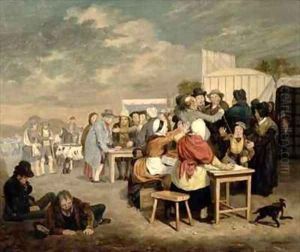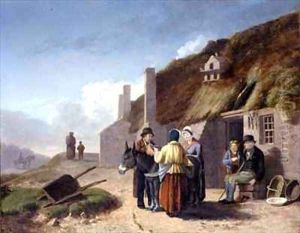Walter Geikie Paintings
Walter Geikie was a notable Scottish artist and etcher born on November 10, 1795, in Edinburgh, Scotland. Despite facing significant personal challenges, he made a lasting impression on the Scottish art scene of the early 19th century. Geikie showed an incredible aptitude for art from a young age, which was particularly remarkable given that he lost his hearing after suffering from a severe illness at the age of two. This disability did not deter him; instead, it may have deepened his observational skills and the sensitivity with which he portrayed his subjects.
Geikie’s education was tailored to his needs, and he was encouraged to pursue art by his family. He studied at the Trustees’ Academy in Edinburgh, which was one of the leading art schools of the time. Under the tutelage of notable artists such as Sir Henry Raeburn, he honed his skills and developed a distinctive style. Geikie excelled in capturing everyday life, with a particular focus on the people and scenes of Edinburgh. His works are characterized by a sense of humor, keen observation, and a touch of caricature, yet they remain sympathetic to the plight of his subjects.
Walter Geikie's career was primarily focused on etching, through which he produced a significant body of work that included a series of etchings titled 'Etchings Illustrative of Scottish Character and Scenery.' This collection, published posthumously, is perhaps his most famous work and remains a valuable record of the social history of Scotland during his time. Geikie's etchings are appreciated for their narrative quality and the way they convey the character and spirit of the Scottish people.
Tragically, Geikie's life and career were cut short when he died on August 1, 1837, at the age of 41. Despite his brief career, his work left a lasting impression on Scottish art. Geikie’s art continues to be celebrated for its contribution to the genre of genre painting and for providing a unique window into the life and times of 19th-century Scotland. His works are held in various collections, including the National Galleries of Scotland, where they continue to be studied and appreciated for their historical and artistic value.

